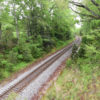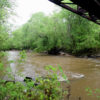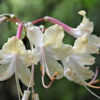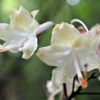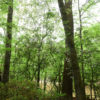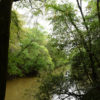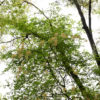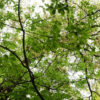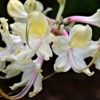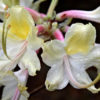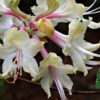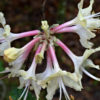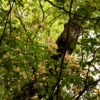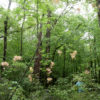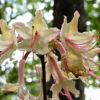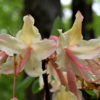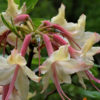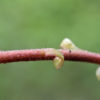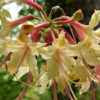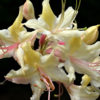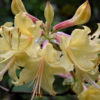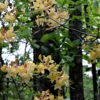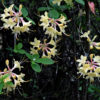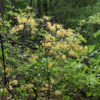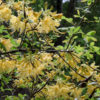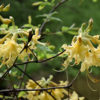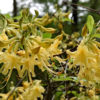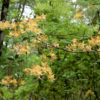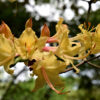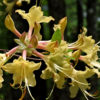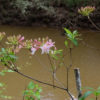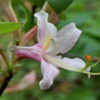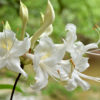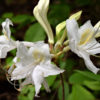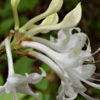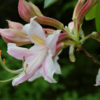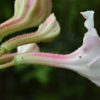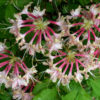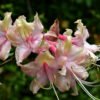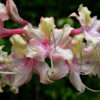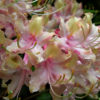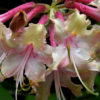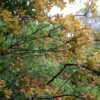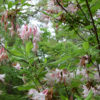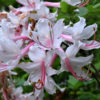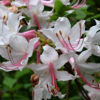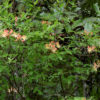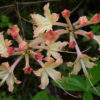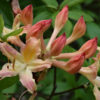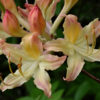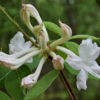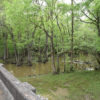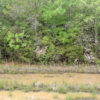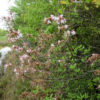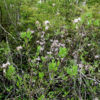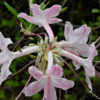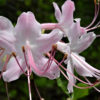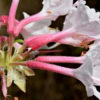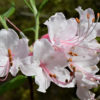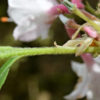Unfortunately most of the time in the rain I was with John and Sally Perkins today at the Pea River in southeast Alabama. It runs roughly from north to south and eventually flows into the Choctawhatchee. I had known for some time that there should be unusual azaleas along the river at about the latitude between the towns of Ariton and Clayton. I had been to two sites in this area before on 20.4.2019 and 1.12.2021 (see there). Now we wanted to look at the whole stretch between the two places of about 40km (25M) length at the best flowering time to maybe find more sites and learn more about these plants. So far the plants had been described as yellow flowering R. colemanii. Considerable doubt about this designation came to me when the plants I had grown from seed collected in 2019 wrre showing clearly fuzzy winter buds, some more and some less, a feature that pointed more to R. austrinum rather than R. colemanii, which always has slick buds. With one or two exceptions, almost all the seedlings had no glandular hairs on the stems, a clear sign of R. colemanii. There was also the fact that the plants in habitat flowered exactly between the blooming times of R. austrinum and R. colemanii. And the flower color of these plants was very often a more or less pale to slightly stronger yellow with a darker yellow spot on the uppermost petal, the tubes whitish to pink or red. Should this be a hybrid swarm between the two species? If one had to imagine a hybrid between R. austrinum with its mostly bright yellow to orange-yellow flowers (from the Choctawhatchee River, to whose system the Pea River belongs) and R. colemanii with its mostly white or pale pink flowers, then it would look pretty much like the plants discussed here. Geographically this fits well, too, as a population of R. austrinum could have reached so far north along the river into the typical range of R. colemanii without any problems. Since both species are tetraploid and flower successively, but of course also with overlaps, there would be little in the way of mass hybridization.
The main difficulty in searching the azaleas over such a long distance was to reach the Pea River often enough. Only bridges were available for this purpose, but there were very few of them in this lonely area. An advance cross-country through the forest, which was growing in a strip of about 1km around the river, was out of the question for reasons of time and practicability alone, especially since forests or fields in private ownership would have had to be crossed first, something that is no problem at all here in Germany as long as one stays on the dirt roads, and in the forest it doesn’t matter anyway. In the USA, however, the rednecks then like to come along with an assortment of shooting irons because they think you want to steal “their” turkeys that live wild there …..
We worked our way from south to north. First we stopped near Ariton at the railway line, the Seaboard Coast Line. I walked the 1,5km (1M) on the tracks to the bridge over the Pea River, where I immediately found a large plant right on the embankment with pale yellow washed out flowers. Because of the rain, which had started in the meantime, I left it with this one plant and didn’t look any further, although there would have been certainly more to discover if I had gone further along the bank.
Our next stop was a few km further north, where CR 77 crosses the Pea River. This was also the place where I had already been on 1.12.2021. Here we only had to walk a few steps through the forest along the river to find several plants at once, all of which had the typical pale yellow flowers with a darker spot. One specimen had slightly darker yellow flowers. Some of the plants were ancient, tree-like and reached heights of about 5 to 6m! While searching for plants, I also stumbled across an abandoned makeshift dwelling that had spread wild and dirty along the shore. Everywhere plastic garbage lay around, so that I spontaneously had the thought that the former inhabitants must have been the species Homo plasticus ssp. horridus, H. sapiens could not have been that in any case. Disgusting to litter nature like this.
The next stop was at the place where the AL 10 crosses the Pea River. Here, after some searching, quite a number plants could be found that fit well into the picture with their pale yellow tones. In between we also found specimens that reminded us more of R. austrinum, and also some that looked more like true R. colemanii. I had been here already on 20.4.2019 and had collected the mentioned seeds, but then the flowering had been as good as over and I had not noticed anything of the variety.
The next place was Hobdys Bridge, where AL 130 crosses the Pea River. Here we found a few plants that appeared to be hybrids, including one with an unusual salmon orange shade on the otherwise pale yellow petals. One plant found there with pure white flowers and shoots without glandular hairs could also have been an R. colemanii.
As the day was slowly running out, we now made a bigger jump north to the place where AL 239 crosses the river. Here, however, we found only some R. canescens and no traces of R. austrinum, R. colemanii, or hybrids between the two species. For a more precise delimitation of the hybrid population, it will be necessary to explore a little further south again from here until one would encounter the first plants. Unfortunately, there was no more time for that. But at least we could detect the hybrids on a distance of about 23km (14.3M).

